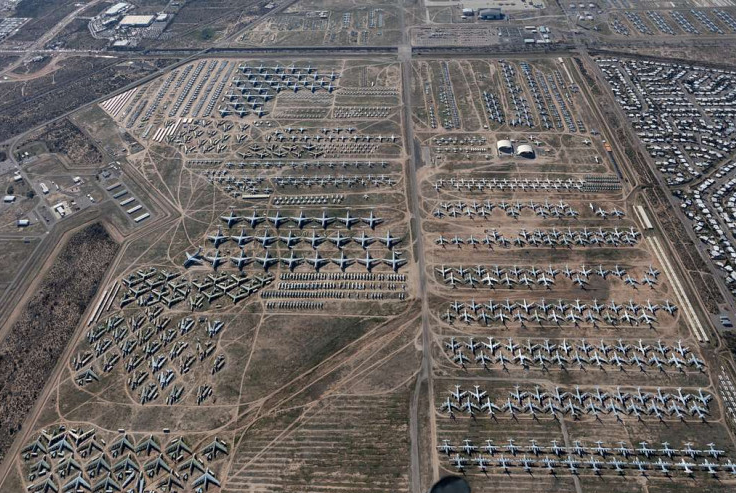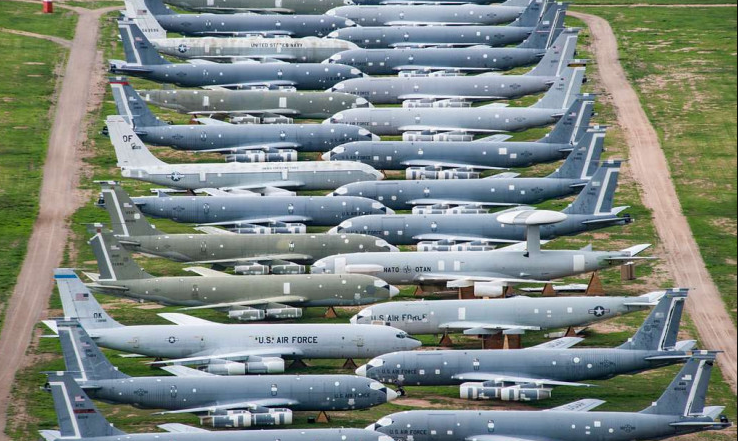Aircraft graveyard
Where do decommissioned planes go? For example, the famous Concorde or Tu-144 were found
If you take the South Kolb Road toTucson, Arizona, you can see the familiar landscape of one-story America replacing the rows of planes. From massive forklifts to heavy bombers, they stand motionless in the scorching desert sun.
What is it?
 Source: Photographs from the Carol M. Highsmith Archives, Library of Congress, Prints and Photographs Division / Picrly
Source: Photographs from the Carol M. Highsmith Archives, Library of Congress, Prints and Photographs Division / Picrly
What's in here?
This is Davis-Monthan Air Force Base.where the 309th Aerospace Maintenance and Repair Group is located. Here, on an area of 10.5 km², about 4,400 aircraft and 13 aerospace vehicles from the US Air Force, Army, Coast Guard, Navy, Marine Corps and National Aeronautics and Space Administration (NASA) live out their lives. There is everything here: from cargo planes to bombers, military transport "Hercules" and F-14 "Tomcat" jet fighter-interceptors, known to viewers from the Hollywood action movie "Top Gun".
 Source: US Department of Defense Visual Information Dissemination Service / Picrly.
Source: US Department of Defense Visual Information Dissemination Service / Picrly.
Despite the fact that there are various types of aircraft at the base, most of the surviving ones belong to the military aviation.
Some of them seem completely new, andothers are closed, you can’t see them - they are closed protective covers that protect aircraft from sand and dust. Not all fighter jets are lucky enough to survive their retirement intact. In some hangars they are stored in the form of a box of spare parts. Here, the remains of the planes are being prepared for shipment to various places around the world to help other steel birds take off into the sky.
Why Arizona?
While Davis-Monthan isn't the world's only airplane graveyard, it is certainly the largest. Why was it built here, in the desert?
There are several reasons for this.Arizona's climate, with its dry heat and low humidity, is ideal for slowing down rust and aircraft deterioration. This makes them less susceptible to corrosion. It is also easier to maintain aircraft in proper working order. In addition, deserts have a lot of space at an affordable price.
Also the geology of the desert with its alkalinethe soil is complex enough to prevent the plane from falling underground. They can be parked in the desert without the need for expensive new ramps.
Airplane shelter
Despite the fact that the airbase is calleda “graveyard” for aircraft; new models are also stored here. Facility technicians keep an eye on them in the warehouse and make sure the plane is free of dirt, dust and wild animals. They regularly check the operation of engines and other equipment to ensure everything is running smoothly.
Due to the COVID-19 pandemic, when mostAs airlines grounded, more planes landed here than at any time in recent history. You can't just leave them at the airport; they require a lot of attention.

“To place one aircraft it takes250 hours. He also requires special checks every 7, 14, and 30 days,” Mark Blet, deputy director of the Roswell International Aviation Center, told Fox News.
Behind the control surfaces of an aircraft oravionics need to be looked after. Personnel should check the fuselage inlets. They need to be closed because they can become tempting nesting houses for birds or insects. Aircraft hydraulic systems contain fluids that must be drained. However, aircraft fuel tanks must remain partially filled to maintain lubrication and increase aircraft weight in windy areas.

Aircraft batteries must be disconnected and againconnect every 14 days. Jet engine launch areas should be covered, as should aircraft windows, to protect them from sunlight. Giant sachets of silica, similar to those found in pill bottles, are placed inside jet engines to keep them dry.
Aircraft tires must be spun up everyone or two weeks so they don't come down. This means that the aircraft must be towed, taxied or jacked up. To prevent rusting, the chassis must be lubricated with hydraulic fluid.
How did the base appear?
The base was founded in 1925 and named in memoryabout Tucson residents, World War I military pilots Samuel Davis and Oscar Monten. In 1940, the base was expanded; bomber aviation crews were trained here. After the war, the Davis-Monthan base was chosen as an “aircraft graveyard.” However, already in 1946, with the beginning of the Cold War, combat units of strategic aviation settled here again - two Boeing B-29 Superfortress air groups.

In early March 1949, a B-50 Superfortresstook off from the Davis-Montain base and performed a non-stop flight around the world (its duration was 94 hours with four refuelings in the air). From 1963 to 1976, Lockheed U-2 spy planes were based here, and since the early 1960s. until 1984 - 18 Titan II silo-based missiles.

In 1976 the command of the strategicaviation transferred the tactical aviation base in the person of the 355th Fighter Wing, based at Davis-Montain to this day. Despite the name, the unit's main strike force is the Fairchild Republic A-10 Thunderbolt II attack aircraft, and the 355th Wing itself is the leading training unit for the USAF's crews of these aircraft.
How to get here?
Now the “cemetery” functions as a MuseumPima Aviation and Aerospace Center, where you can take a tour of the 309th Aerospace Maintenance and Remanufacturing Center (AMARG).
To read Further
See a heavy attack drone that carries a ton of weapons
Scientists have been unable to catch Rambo's fox for three years. It prevents rare animals from being released into the forest.
A spaceship several kilometers away: everything that is known about China's new project